
12 Best Content Marketing Tools for 2025
Published on 2025-11-09
Creating standout content is only half the battle. The other half is ensuring it reaches the right audience, drives engagement, and ultimately, achieves your business goals. This is where the right technology becomes a non-negotiable part of your strategy. Without a solid toolkit, even the most brilliant content can get lost in the noise, failing to deliver the return on investment you need. The challenge isn't a lack of options; it's the overwhelming number of them, each promising to be the ultimate solution.
This guide cuts through that clutter. We provide a straightforward, in-depth analysis of the best content marketing tools available today, designed for everyone from solo entrepreneurs to established marketing teams. We've gone beyond surface-level descriptions to give you practical insights into how these platforms function in the real world. You won't find generic marketing copy here. Instead, you'll get an honest look at what works, what doesn't, and which tool is genuinely the best fit for specific tasks.
To truly navigate the complexities of modern content, understanding the landscape of available solutions is crucial. You can dive deeper into a comprehensive guide to the best content creation tools to master the initial phase of your workflow.
In this resource, we'll explore platforms that cover the entire content lifecycle:
- Strategy and Ideation: Tools like Semrush and Ahrefs for identifying winning topics.
- Creation and Optimization: Platforms such as Jasper, Canva, and Grammarly for producing high-quality assets.
- Distribution and Promotion: Solutions including Buffer and Mailchimp for getting your content seen.
- Analytics and Performance: HubSpot’s all-in-one suite for measuring what matters.
Each review includes detailed feature breakdowns, clear pros and cons, pricing information, and screenshots, so you can make an informed decision without guesswork. Let's find the perfect tools to build and scale your content marketing engine.
1. autoghostwriter
Best For: AI-powered LinkedIn content creation and research
autoghostwriter is an AI-first content engine specifically designed to master LinkedIn. It addresses the platform’s biggest challenge: consistently creating authentic, attention-grabbing posts that don't sound generic. Where other tools focus solely on generation, autoghostwriter anchors its workflow in research, making it one of the most strategic best content marketing tools for social media professionals.
Its standout feature is an inspiration feed containing over 100,000 proven viral posts. This allows users to deconstruct what already works, identify trending topics, and validate ideas before writing. This research-first approach significantly reduces the guesswork often associated with content creation, ensuring your efforts are grounded in data-backed formats and hooks.

Key Features & Use Cases
The platform’s power lies in its integrated workflow. Users can establish multiple LinkedIn personas to ensure the AI-generated content from its custom engine, Honey AI, aligns with a specific professional voice, whether it's a CEO, a founder, or a freelance consultant.
- Ideation & Research: Use the inspiration feed to find high-performing posts related to your niche. Filter by keyword, engagement, or author to quickly build a content calendar based on proven concepts.
- Drafting & Refinement: Once you have an idea, Honey AI generates complete, well-formatted drafts with strong hooks, re-hooks, and clear calls-to-action.
- Asset Creation: The built-in AI image generator eliminates the need for a separate tool, allowing you to create custom visuals that complement your posts directly within the platform.
- Performance Tracking: An integrated engagement tracker helps you monitor what’s working, enabling you to double down on successful themes and formats.
Pricing
autoghostwriter offers a transparent pricing model with a 7-day free trial.
- Premium: $59/month for 100 posts.
- Pro: $99/month for 500 posts, plus priority support and cold DM scripts.
- Custom enterprise plans may be available for teams with higher volume needs.
Pros & Cons
| Pros | Cons |
|---|---|
| Research-driven workflow with 100,000+ viral post examples. | AI drafts require human review for brand nuance and technical accuracy. |
| Authentic AI outputs from persona-driven templates and Honey AI. | High-volume users or agencies may need custom plans beyond standard tiers. |
| All-in-one platform replaces separate tools for ideation, writing, and images. | No public awards or certifications are listed on the site. |
| Scalable plans with a 7-day free trial to test the full feature set. |
| Website: | https://autoghostwriter.com |
|---|
2. HubSpot Marketing Hub
HubSpot Marketing Hub goes beyond being just a content creation tool; it's a comprehensive, all-in-one platform designed to manage the entire customer lifecycle. It stands out by tightly integrating its content management system (CMS), marketing automation, and a powerful CRM. This connection is its core strength, allowing marketers to not only create and distribute content but also to track its direct impact on lead generation and revenue.
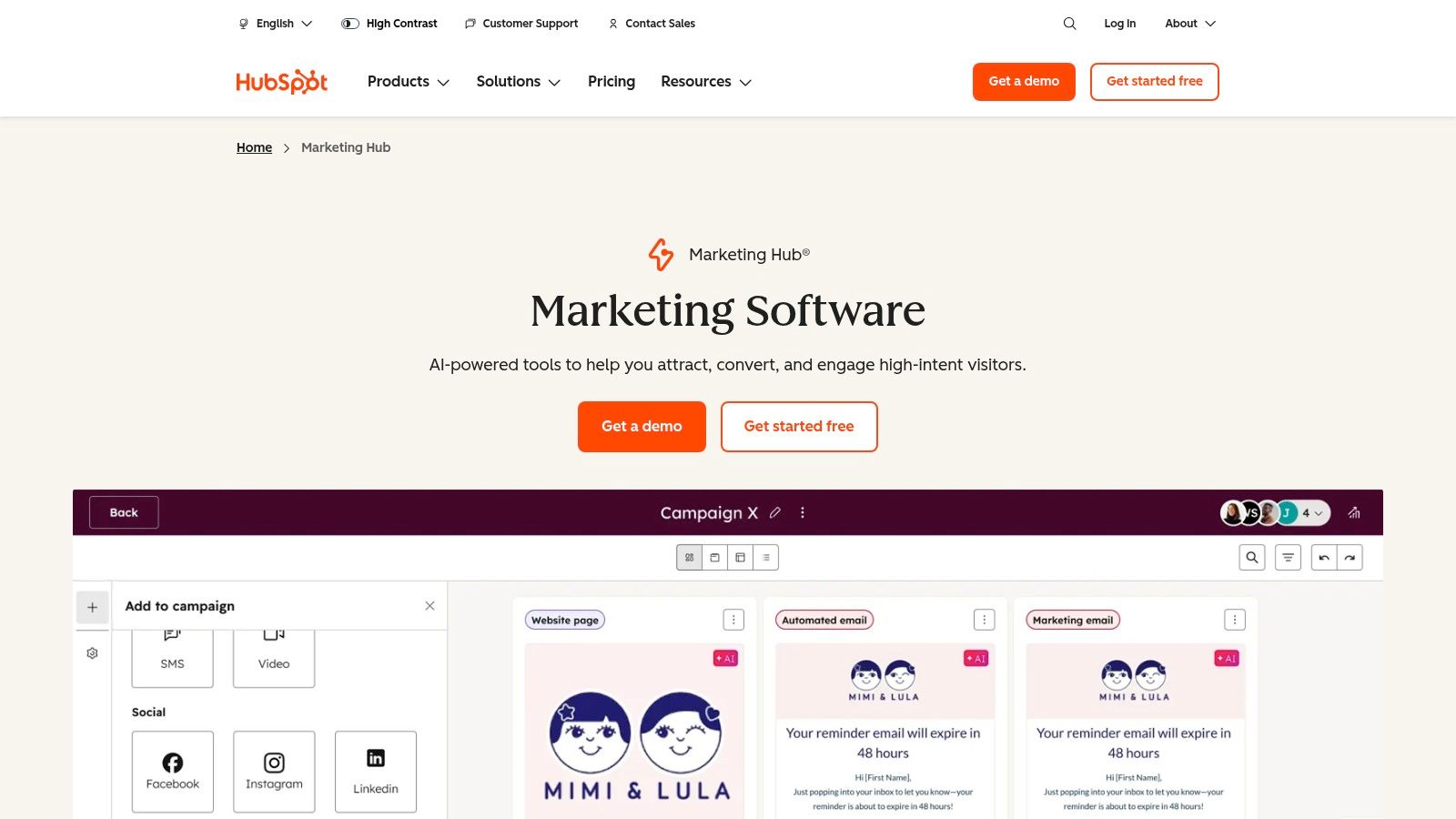
This platform is one of the best content marketing tools for teams that need to prove ROI and connect their efforts to sales outcomes. Instead of guessing which blog post influenced a deal, HubSpot’s reporting shows you the exact customer journey. It's ideal for businesses looking to scale their marketing operations with a unified system rather than patching together multiple disparate tools.
Key Features & Use Cases
- Integrated CRM & Analytics: Automatically track every interaction a contact has with your content. Use this data to build segmented lists for highly targeted email campaigns.
- Visual Automation Builder: Create complex, multi-channel nurture sequences for new leads. For example, you can trigger an email series after a user downloads an ebook, then notify sales when they visit the pricing page.
- AI Content Assistant: Leverage AI to quickly generate blog post outlines, social media copy, and email subject lines, speeding up the content creation process.
- Extensive Onboarding: HubSpot Academy offers free, comprehensive courses and certifications, making it easier to train your team and master the platform.
A significant benefit is the ability to see how your marketing assets perform. You can conduct a deep dive into your content performance analysis to understand which pieces drive the most engagement and conversions.
| Pros | Cons |
|---|---|
| Mature, all-in-one platform with deep analytics | Onboarding fees for Professional & Enterprise plans |
| Strong educational resources (HubSpot Academy) | Contact-based pricing can become expensive |
| Free tier available to start using the CRM | Can be overly complex for very small teams |
Website: https://www.hubspot.com/products/marketing
3. Semrush
Semrush is a powerhouse for data-driven content marketing, extending far beyond simple keyword research. It's a comprehensive suite designed for planning, executing, and measuring content strategies based on competitive intelligence and search engine performance. Its primary strength lies in its vast database, allowing marketers to reverse-engineer competitor successes and identify high-value content opportunities.
This platform is one of the best content marketing tools for teams that need to dominate search rankings and build topical authority. Instead of creating content blindly, Semrush provides data-backed briefs and templates that guide writers on what to include for a better chance at ranking. It's ideal for businesses in competitive niches looking to gain an edge through superior SEO and content planning.
Key Features & Use Cases
- Topic Research & Content Templates: Enter a seed keyword to get a mind map of related topics, headlines, and questions. From there, generate a detailed content brief with SEO recommendations for your writers.
- Content Gap Analysis: Compare your domain against multiple competitors to find keywords they rank for but you don't. This is a quick way to discover new, relevant content ideas for your calendar.
- Position Tracking: Monitor your website's daily rankings for a target set of keywords across different locations and devices. Use this to measure the direct SEO impact of your published content.
- Backlink Analytics: Analyze your own and competitors' backlink profiles to identify link-building opportunities and inform your content distribution and outreach strategy.
The ability to generate client-ready reports is a major benefit, allowing agencies and in-house marketers to clearly communicate content performance and ROI to stakeholders.
| Pros | Cons |
|---|---|
| Broad data coverage for ideation and performance tracking | Learning curve for new users due to the platform's depth |
| Strong competitive intelligence and reporting features | Tier and seat limits plus add-ons can increase the total cost |
| Free trials are available for multiple toolkits | Can be overwhelming for users only needing basic SEO features |
Website: https://www.semrush.com/pricing/
4. Ahrefs
Ahrefs is a powerhouse SEO and content intelligence platform built around one of the industry's most robust backlink and keyword databases. It excels at providing the deep competitive insights needed to create content that ranks, attracts traffic, and earns authoritative links. Its core strength is its vast web crawler, which fuels tools that let you reverse-engineer the success of your competitors' content and SEO strategies.
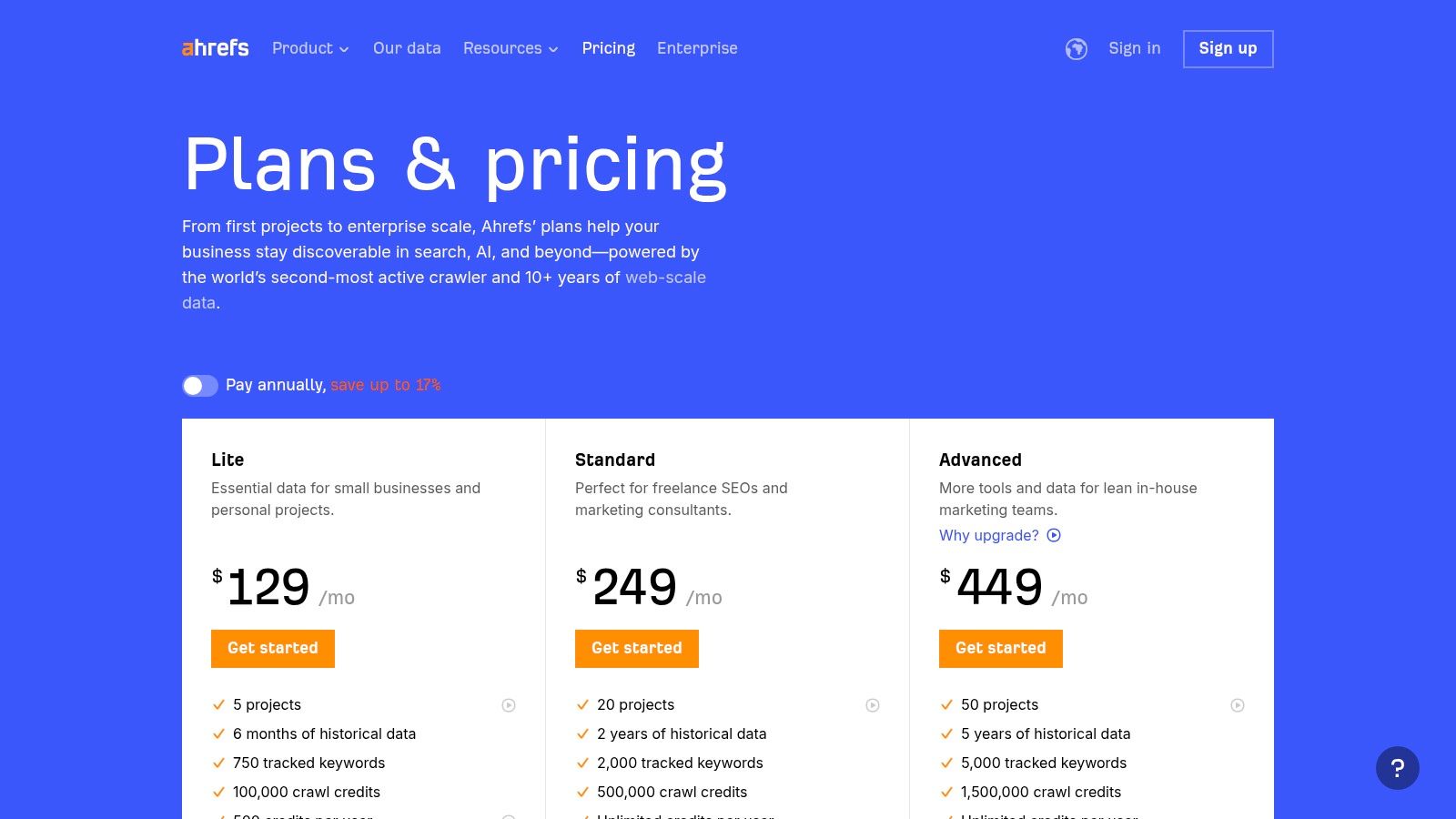
This platform is one of the best content marketing tools for teams that ground their strategy in data-driven SEO. Instead of creating content and hoping it performs, Ahrefs allows you to identify proven topics with high traffic potential and a clear path to ranking. It is ideal for content marketers and SEO professionals who need granular data to justify content decisions, perform in-depth keyword research, and track performance against competitors.
Key Features & Use Cases
- Keywords Explorer: Discover thousands of relevant keyword ideas, analyze their ranking difficulty, and calculate their traffic potential. Use it to find low-competition topics your audience is searching for.
- Site Explorer: Analyze any competitor's website to see their top organic keywords, backlink profile, and highest-performing content pages. This is perfect for identifying content gaps you can fill.
- Content Gap Analysis: Enter your domain and a few competitors to find keywords they rank for that you don't. This instantly reveals valuable content opportunities you may have missed.
- Rank Tracker & Site Audit: Monitor your keyword rankings across different locations and devices, and run technical SEO audits to find and fix issues that could be holding your content back.
A significant benefit is the ability to move from high-level strategy to tactical execution. You can use Keywords Explorer to find a target topic and then use Site Explorer to analyze the top-ranking pages to understand what it takes to compete.
| Pros | Cons |
|---|---|
| Best-in-class backlink and SERP intelligence | Premium pricing, especially at higher usage limits |
| Fast, reliable reporting with granular exports | Some features and add-ons cost extra |
| Free Webmaster Tools for basic site owners | Can be complex for beginners without SEO knowledge |
Website: https://ahrefs.com/pricing
5. Canva
Canva has become the go-to visual design suite for marketers who aren't graphic designers. It democratizes design by making it incredibly simple to create professional-looking social media graphics, blog banners, infographics, and even short videos. Its core strength lies in its vast template library and intuitive drag-and-drop editor, empowering entire teams to produce on-brand visual content quickly and consistently.
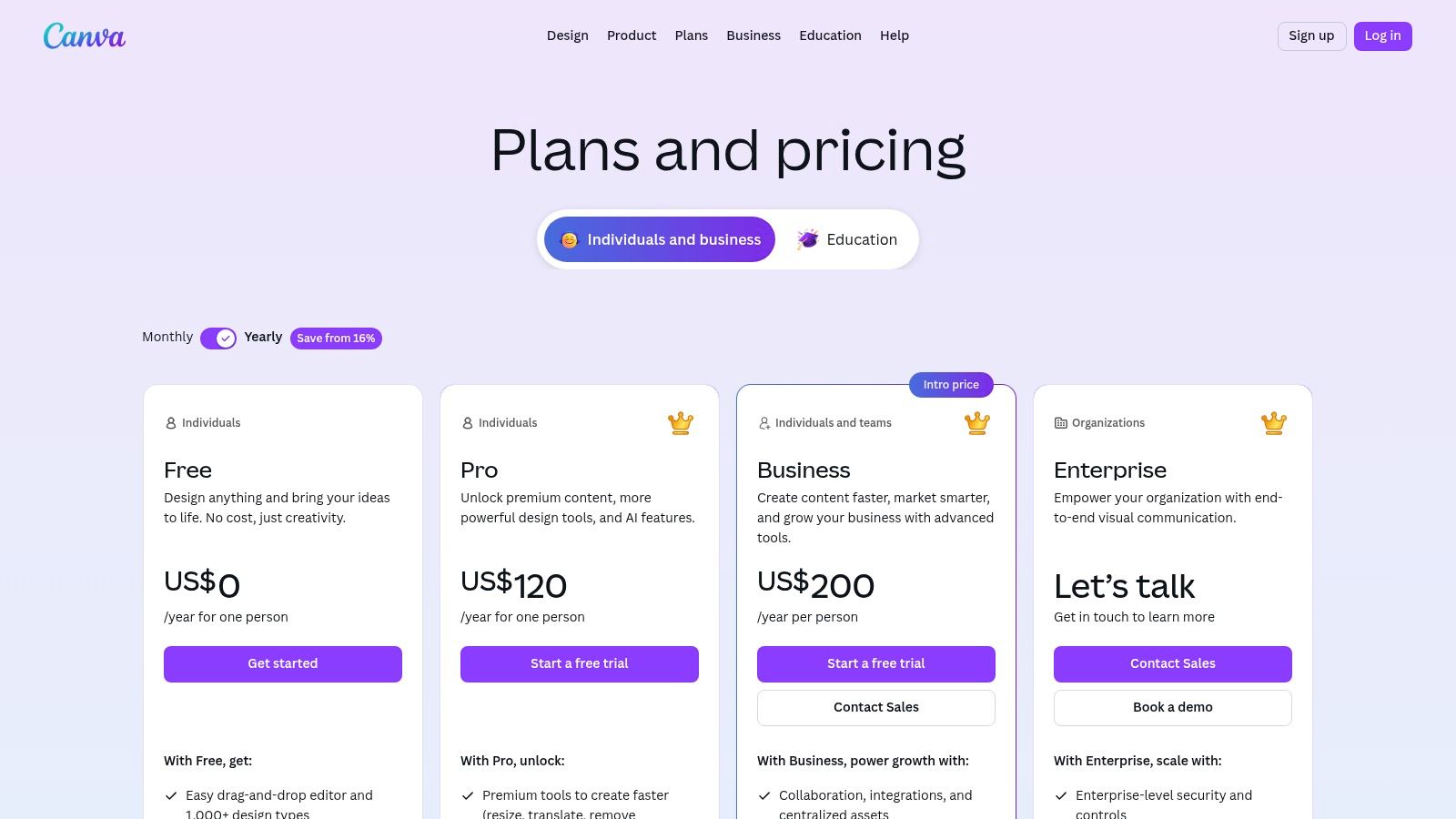
This platform is one of the best content marketing tools for teams needing to accelerate asset production without sacrificing brand identity. Instead of relying on a dedicated designer for every small task, social media managers and content creators can self-serve. This dramatically speeds up campaign execution and allows for more agile and responsive marketing, which is essential for fast-paced digital environments.
Key Features & Use Cases
- Template Library & Brand Kits: Quickly start any design with a template and apply your brand's colors, fonts, and logos with one click for perfect consistency.
- Magic Studio AI Tools: Use AI features like Magic Write for copy, Text to Image for custom visuals, and a background remover to speed up the creative workflow significantly.
- Team Collaboration & Approvals: Work on designs together in real-time, leave comments, and set up approval workflows to ensure all content is reviewed before publishing.
- Content Planner & Publishing: Schedule your finished designs to be posted directly to social media platforms like Instagram, LinkedIn, and Facebook from within Canva.
A key benefit is how Canva streamlines the creation of multi-image posts like carousels. For a deeper look, you can learn more about how to create AI carousels with Canva.
| Pros | Cons |
|---|---|
| Very fast to produce on-brand visual assets | Some AI and advanced features are gated to higher-tier plans |
| Accessible to non-designers with strong collaboration features | Pricing model for teams has changed; verify which plan fits your needs |
| Broad export options and direct social media integrations | Can feel limiting for professional designers used to Adobe Creative Suite |
Website: https://www.canva.com/pricing/
6. Buffer
Buffer is a streamlined social media management platform focused on simplicity and consistency, making it an excellent choice for small businesses and individual creators. It excels at the core tasks of planning, scheduling, and publishing content across multiple social channels without the complexity of larger enterprise suites. Its straightforward interface and clean content calendar allow users to quickly get a visual overview of their entire social media pipeline.
This platform is one of the best content marketing tools for teams that prioritize an easy-to-use scheduler and predictable pricing. Rather than bundling dozens of advanced features, Buffer focuses on doing the fundamentals exceptionally well. It's ideal for marketers who need to maintain a consistent posting cadence to build their audience but don't require deep, complex analytics or advanced team collaboration features found in more expensive tools.
Key Features & Use Cases
- Intuitive Content Calendar: Visually plan and drag-and-drop posts across a weekly or monthly calendar view. This is perfect for ensuring a balanced content mix across channels like Instagram, LinkedIn, and Facebook.
- Simple Post Scheduling: Create a post once and customize it for different platforms. For example, add hashtags for Instagram, a link for LinkedIn, and a different image for X (formerly Twitter), all from a single composer.
- AI Assistant: Quickly generate post ideas, rewrite copy in different tones, or repurpose existing content for various social networks, helping to overcome writer's block.
- Basic Analytics & Reporting: Track key metrics like reach, engagement, and follower growth for each profile to understand what content resonates with your audience.
A key benefit is its user-friendly design, which significantly reduces the learning curve, allowing new team members to start scheduling content almost immediately.
| Pros | Cons |
|---|---|
| Very easy to learn with transparent pricing | Analytics are lighter compared with enterprise social suites |
| Good value for small content teams | Per-channel pricing can add up when managing many profiles |
| Free plan and trials available to get started | Lacks the advanced collaboration tools of platforms like Sprout |
Website: https://buffer.com/pricing
7. Mailchimp
Mailchimp is a powerhouse in email marketing, but its capabilities extend into a broader marketing automation platform ideal for content distribution. It excels at helping businesses build and nurture an audience through newsletters, automated email sequences, and targeted campaigns. Its primary strength is its user-friendly interface, which makes sophisticated email marketing accessible even to beginners.
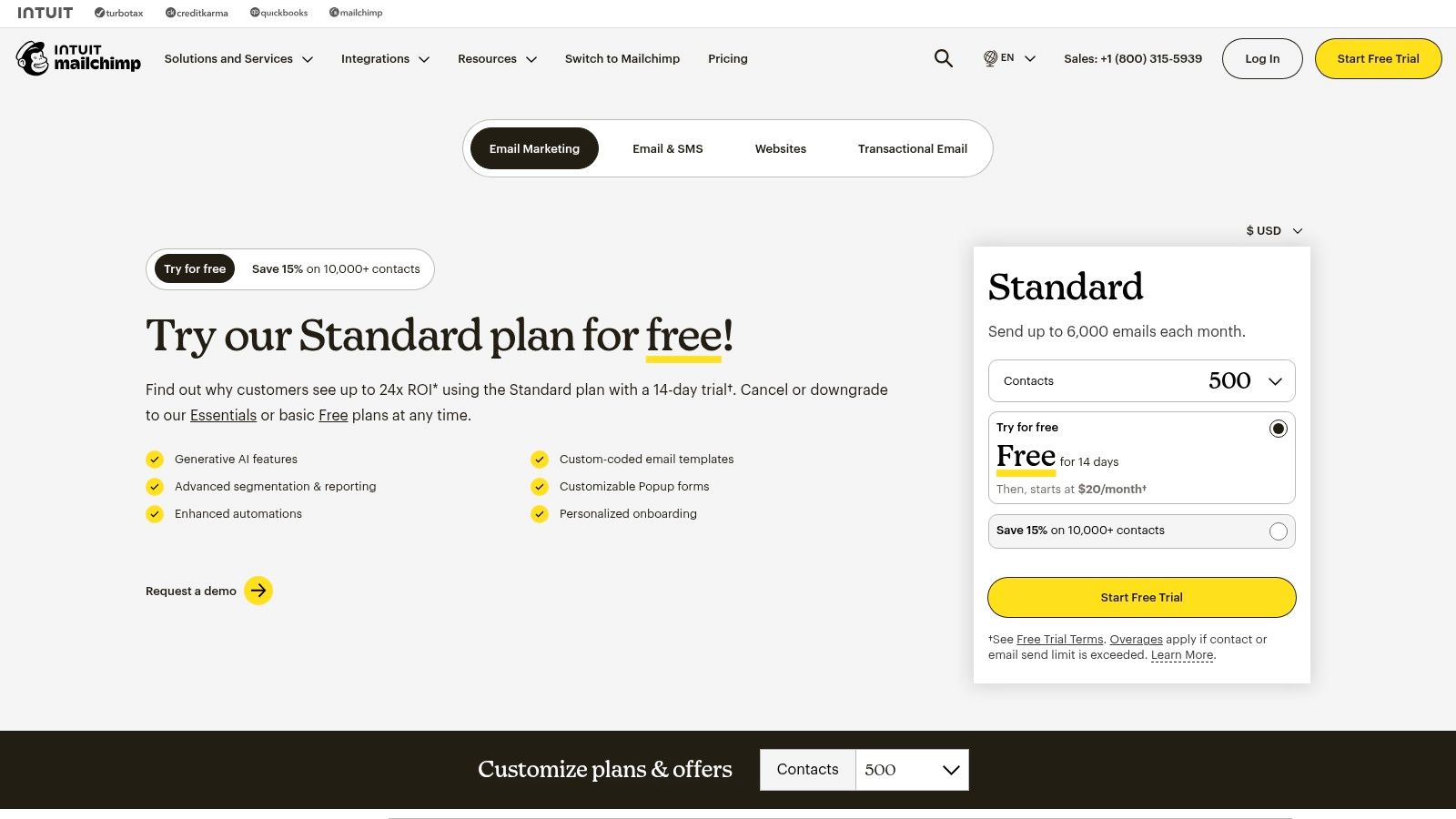
This platform is one of the best content marketing tools for creators and small businesses focused on growing a direct channel with their audience. Instead of just publishing content, Mailchimp allows you to deliver it directly to subscribers' inboxes, driving repeat traffic and building brand loyalty. It's perfect for scaling a newsletter, promoting new blog posts, or distributing lead magnets like ebooks and whitepapers.
Key Features & Use Cases
- Email Automation & Visual Journeys: Create automated welcome series for new subscribers or build custom workflows based on user behavior. For instance, you can automatically send a follow-up email to contacts who clicked a specific link in your last newsletter.
- Audience Segmentation: Group your audience based on their interests, engagement, or purchase history. This allows you to send highly relevant content, increasing open rates and click-throughs.
- Generative AI Assistant: Use AI to help draft email subject lines, body copy, and campaign text, overcoming writer's block and optimizing your messaging for better performance.
- Landing Pages & Simple CRM: Quickly build landing pages to capture leads for your content offers. The built-in CRM helps you manage contact information and track interactions without needing a separate tool.
A key advantage is the platform's focus on analytics. You can easily track open rates, click maps, and campaign ROI to understand what content resonates most with your audience.
| Pros | Cons |
|---|---|
| Familiar UI with extensive tutorials and integrations | Cost scales significantly with contact count and send limits |
| Scales from a generous Free plan to Premium tiers | Advanced automation features are gated behind higher tiers |
| Easy entry point to launch and grow a newsletter program | Can become less cost-effective than dedicated CRM platforms |
Website: https://mailchimp.com/pricing
8. Jasper
Jasper is an AI content creation platform built specifically for the demands of marketing teams. Unlike more general-purpose AI writers, it focuses on generating high-quality copy for campaigns, ads, emails, and product descriptions while maintaining strict brand consistency. Its core advantage lies in its governance and team-oriented features, making it a go-to tool for businesses that need to scale content creation without sacrificing their unique brand voice.
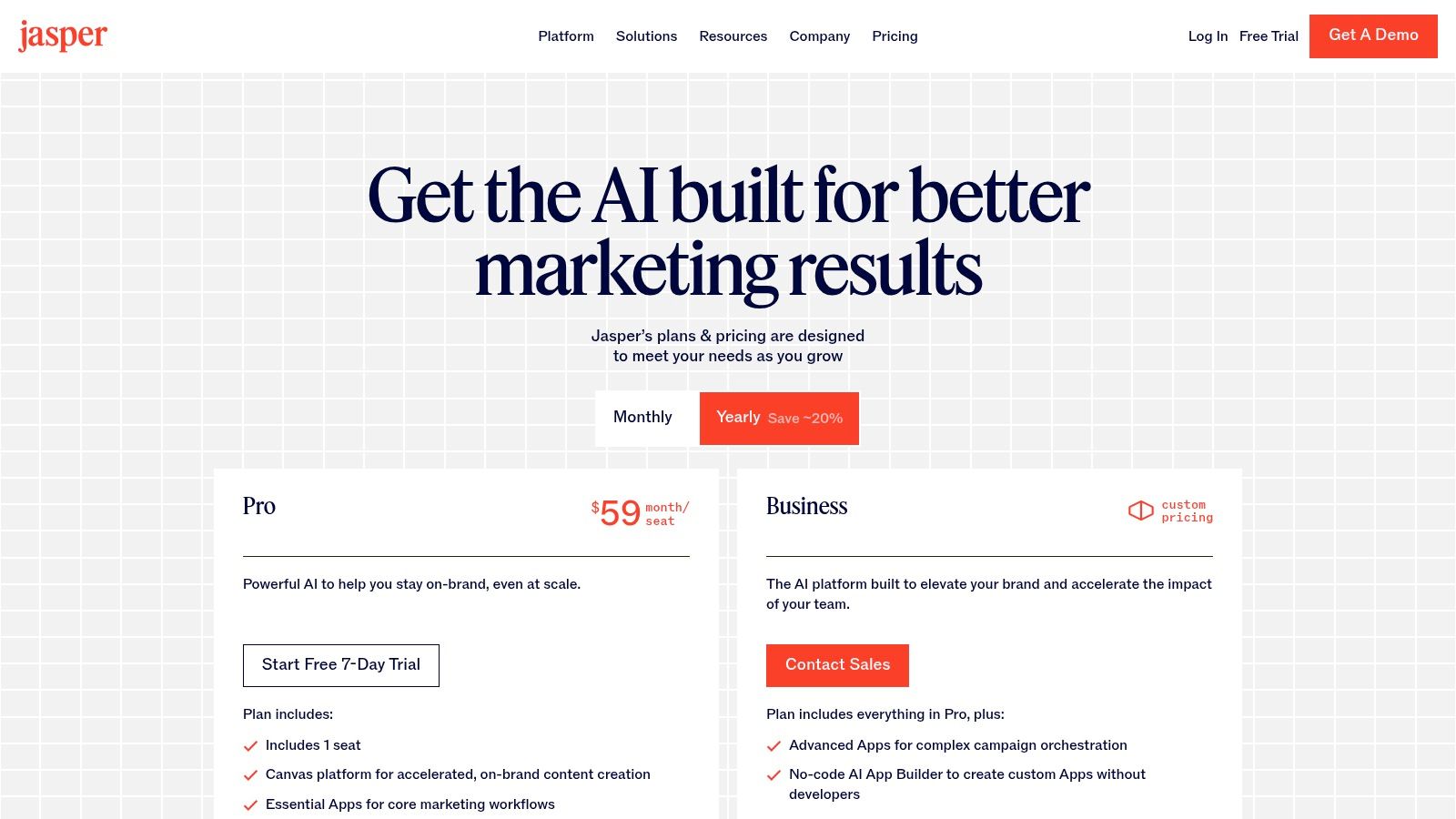
This platform is one of the best content marketing tools for teams that prioritize brand alignment and workflow efficiency. It moves beyond simple text generation by incorporating your brand’s knowledge base, style guide, and target audience personas directly into the AI. This ensures that every piece of content, from a social media post to a detailed landing page, sounds like it came from your team. For those exploring AI's role in content, a deeper dive into Jasper's capabilities can provide more context.
Key Features & Use Cases
- Brand Voice & Knowledge: Upload your style guides, product information, and company facts to create a custom AI that understands and writes in your specific brand voice.
- Marketing-Specific Workflows: Use pre-built templates and workflows designed for common marketing tasks like creating comprehensive ad campaigns, writing SEO-optimized blog posts, or generating email sequences.
- Canvas Workspace: A long-form document editor that combines AI commands with standard editing tools, allowing for a collaborative and flexible content creation process.
- Enterprise Governance: For larger teams, Jasper offers features like SOC 2 compliance, user permissions, and performance analytics to ensure content is secure and on-brand.
A major benefit is its ability to streamline collaborative efforts. Multiple users can work within the same platform, leveraging the same brand assets to ensure consistency across all marketing channels.
| Pros | Cons |
|---|---|
| Designed around marketing use cases, not just generic chat | Per-seat pricing can be costly for larger teams |
| Strong brand control and governance features for teams | Advanced features reserved for Business plans |
| Multi-user features enhance collaborative workflows | May require a learning curve to master all features |
Website: https://www.jasper.ai/pricing
9. Grammarly
Grammarly is an essential AI-powered writing assistant that goes far beyond a simple spell-checker. It serves as a foundational layer for any content marketing strategy by ensuring every piece of content, from blog posts to social media updates, is clear, professional, and on-brand. Its core value lies in its real-time feedback on grammar, style, tone, and clarity, acting as an instant editor that helps polish copy before it ever reaches an audience.
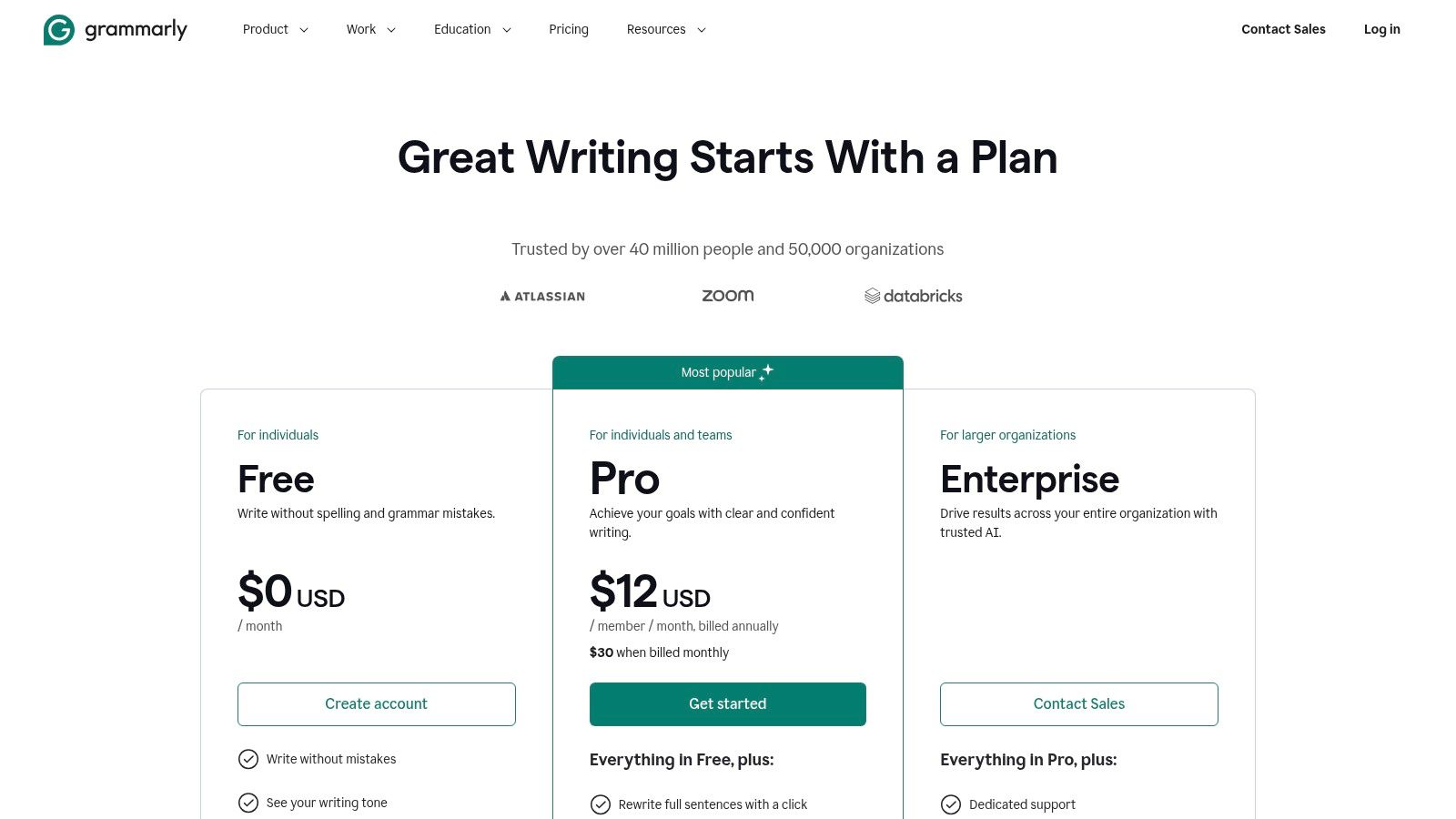
This platform is one of the best content marketing tools for teams aiming to maintain a high standard of quality and consistency across all written materials. By integrating directly into browsers, email clients, and document editors, it seamlessly becomes part of the workflow, reducing editing cycles and empowering every team member to write with confidence. For marketing organizations, the enterprise features provide crucial governance, allowing them to set a consistent brand voice.
Key Features & Use Cases
- Real-Time Writing Assistance: Get instant suggestions for grammar, spelling, punctuation, clarity, and conciseness as you write an email, a landing page, or a social media post.
- Tone Detection & Adjustment: Ensure your message lands as intended. Grammarly analyzes your word choice and phrasing to identify the tone (e.g., confident, formal, friendly) and offers suggestions to match it to your goal.
- Cross-App Integrations: Use the browser extension, desktop app, or mobile keyboard to maintain writing quality across Gmail, Google Docs, Slack, LinkedIn, and dozens of other platforms.
- Team Style Guides (Business/Enterprise): Create and enforce a centralized style guide. This ensures everyone in the organization uses consistent terminology, branding, and tone, which is critical for a unified brand presence.
A key benefit is its ability to elevate the writing skills of the entire team. It not only corrects mistakes but also explains the reasoning, helping users become stronger writers over time.
| Pros | Cons |
|---|---|
| Easy to deploy across a marketing organization | Requires an internet connection for full functionality |
| Significantly reduces editing time and improves quality | Advanced governance and style guides are on higher-tier plans |
| Free plan available for basic grammar and spelling | Can occasionally provide suggestions that alter intended meaning |
Website: https://www.grammarly.com/plans
10. G2 (Content Marketing Software Category)
Instead of being a single tool, G2's Content Marketing category is a peer-reviewed marketplace that aggregates hundreds of solutions. It serves as a crucial starting point for your research, allowing you to discover, compare, and shortlist the best content marketing tools based on verified user reviews and data. Its primary strength is providing a high-level, unbiased view of the software landscape.
This platform is invaluable for marketers tasked with finding new software to fill a specific gap in their tech stack. Rather than relying solely on vendor marketing copy, you can see how real users rate tools on features, ease of use, and customer support. It helps you build a confident shortlist before you even start a free trial, saving significant time and resources during the procurement process.
Key Features & Use Cases
- Filterable Product Grids: Quickly narrow down options based on criteria like company size, user satisfaction ratings, and specific features to find tools tailored to your needs.
- Verified User Reviews: Gain insights into the real-world performance of a platform. Use reviews to identify common pain points or standout features that aren't mentioned on a vendor's website.
- Direct Vendor Comparisons: Create side-by-side comparison tables for your top choices, allowing you to objectively evaluate features, pricing models, and user feedback in one place.
- Category Hubs: Explore subcategories like Content Creation, Distribution, and Analytics to discover niche tools you may not have been aware of.
A key benefit is its role in vendor discovery. You can quickly move from identifying a need to evaluating potential solutions and connecting directly with vendors for demos or trials.
| Pros | Cons |
|---|---|
| Broad coverage and up-to-date category pages | Some review incentives exist, so read critically |
| Helpful for shortlisting and direct vendor discovery | Listings vary in depth; vendor sites have full details |
| Free to browse and compare software | The sheer number of options can feel overwhelming |
Website: https://www.g2.com/categories/content-marketing
11. Capterra (Content Marketing Software Directory)
Capterra isn't a content marketing tool itself but rather a comprehensive software directory and buyer's guide. It earns its spot on this list by being an indispensable resource for discovering and comparing the vast landscape of available platforms. Instead of relying on a few well-known names, Capterra allows marketers to find niche solutions tailored to specific needs, from small business-focused tools to enterprise-level systems.
This platform is one of the best content marketing tools for research and due diligence. It excels at helping you create a shortlist of vendors based on criteria like company size, deployment type (cloud or on-premise), and essential features. Its side-by-side comparison feature and user reviews provide a solid starting point for any team looking to invest in new software, ensuring a more informed decision-making process.
Key Features & Use Cases
- Advanced Filtering: Narrow down hundreds of options by filtering for specific features you need, such as "editorial calendar," "SEO," or "analytics," to find tools that match your exact workflow.
- Buyer’s Guides & Pricing Snapshots: Access curated guides and at-a-glance pricing information to quickly understand a tool's market position and affordability without visiting every vendor's website.
- Side-by-Side Comparisons: Select a few top contenders and compare their features, ratings, and pricing models directly on the platform to streamline your evaluation.
- Discover Niche Vendors: Use the directory to move beyond mainstream options and discover lesser-known or industry-specific tools that might be a better fit for your team.
A key benefit is the ability to quickly scan numerous alternatives. If a popular tool doesn't meet your needs, Capterra's vendor pages often list direct competitors, providing an immediate path to other potential solutions.
| Pros | Cons |
|---|---|
| Easy to scan many options quickly | Sponsored placements can appear high in the listings |
| Useful filters to match budget and features | Must vet listings carefully and visit vendor sites for full details |
| Good for discovering lesser-known tools | User reviews may not always reflect a tool's current feature set |
Website: https://www.capterra.com/content-marketing-software/
12. AWS Marketplace (Advertising & Marketing solutions)
AWS Marketplace offers a different approach to acquiring the best content marketing tools, targeting enterprises that already leverage Amazon Web Services. It is not a single tool but a curated digital catalog where companies can find, buy, and deploy third-party software and services. Its primary strength is simplifying procurement and billing by consolidating software purchases into a single AWS invoice, streamlining vendor management for large organizations.
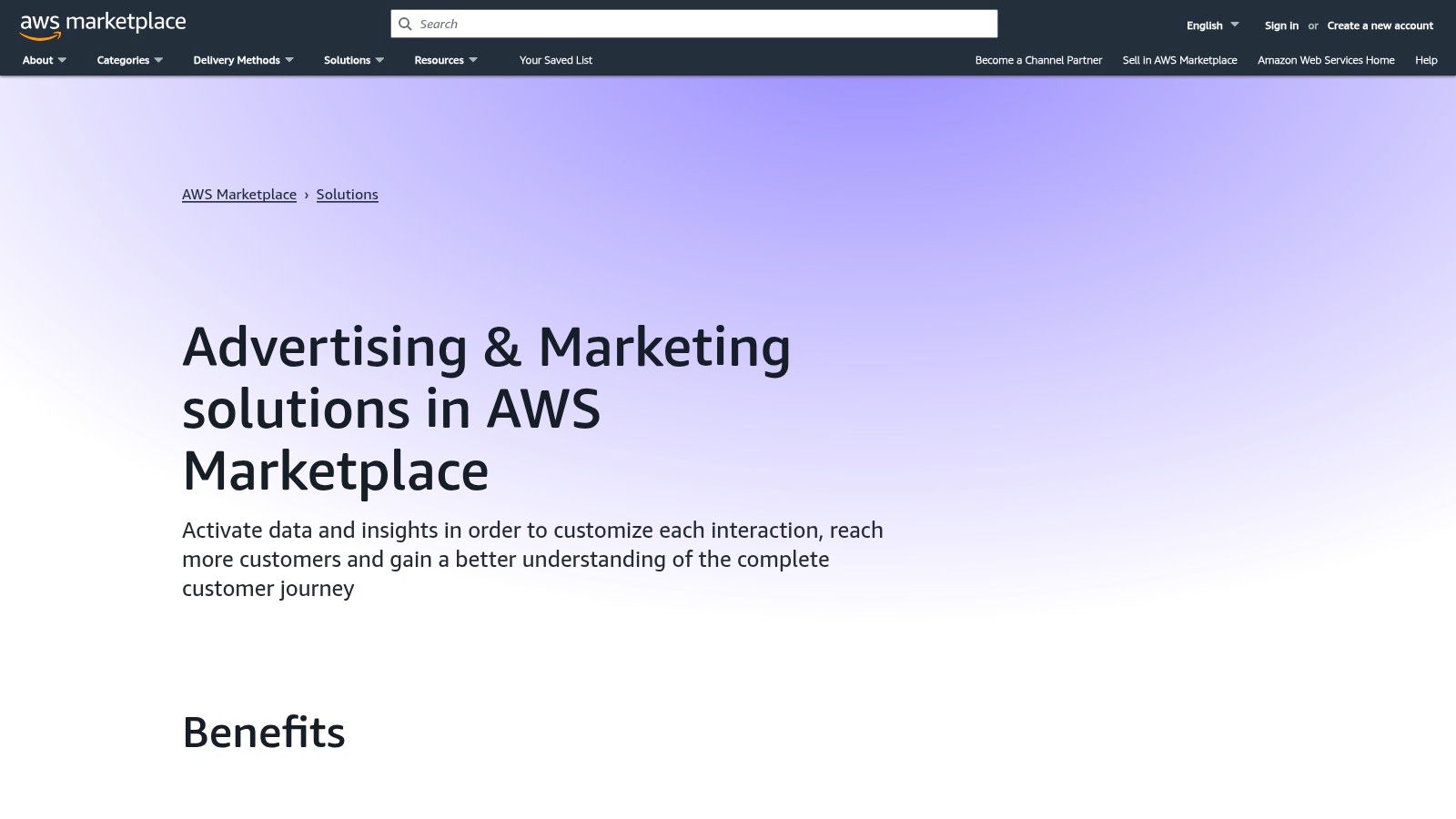
This platform is ideal for enterprise marketing teams operating within a broader AWS ecosystem. Instead of navigating separate procurement processes for each new tool, they can use their existing AWS agreements and budget. This centralization simplifies security reviews, contract negotiations, and financial reporting, making it easier to adopt new marketing technologies without creating administrative bottlenecks.
Key Features & Use Cases
- Centralized Billing & Procurement: Purchase various marketing SaaS solutions and have them appear on your company's unified AWS bill, simplifying expense management.
- Curated Advertising & Marketing Catalog: Browse a specific category filled with tools for analytics, content management, customer experience, and more, all vetted for AWS compatibility.
- Private Offers & Negotiable Terms: Engage directly with software vendors to negotiate custom pricing, terms, and private listings that aren't publicly visible.
- Simplified Deployment: Many tools offer streamlined deployment options, including direct integration with your existing AWS infrastructure.
A key benefit is the ability for technical and marketing departments to align on software acquisition, as tools are procured through a familiar, IT-approved channel.
| Pros | Cons |
|---|---|
| Enterprise-friendly procurement with negotiable terms | Catalog depth and listing detail vary by vendor |
| Simplifies vendor management and billing for existing AWS customers | Not ideal for very small teams or those outside the AWS ecosystem |
| Broad catalog for enterprise software acquisition | Finding the right tool can require more research than a direct sale |
Website: https://aws.amazon.com/marketplace/solutions/advertising-marketing
Top 12 Content Marketing Tools Comparison
| Tool | Core features | Target (👥) | Pricing / Value (💰) | Quality (★) | Unique selling point (✨) |
|---|---|---|---|---|---|
| autoghostwriter 🏆 | Persona templates • Honey AI • 100k+ inspiration feed • AI images | 👥 LinkedIn creators • founders • agencies | 💰 $59/100 posts · $99/500 posts · 7‑day trial | ★★★★☆ | ✨ Research‑first viral examples + end‑to‑end LinkedIn workflow |
| HubSpot Marketing Hub | Marketing automation • CRM • Ads & analytics • A/B testing | 👥 Marketing teams • mid→enterprise | 💰 Free→Enterprise; onboarding fees on Pro+ | ★★★★☆ | ✨ Unified CRM + campaign automation |
| Semrush | Keyword/topic research • SERP & competitor analysis • Content briefs | 👥 SEO/content teams • agencies | 💰 Tiered subscriptions + add‑ons | ★★★★☆ | ✨ Broad competitive & keyword data for ideation |
| Ahrefs | Backlink index • Keywords Explorer • Site audit • Rank tracking | 👥 SEO pros • link builders | 💰 Premium tiers; seat/usage limits | ★★★★☆ | ✨ Industry‑leading backlink & SERP intelligence |
| Canva | Templates • Brand kits • Magic Studio AI • Collaboration | 👥 Marketers • designers • social teams | 💰 Free + Pro/Teams; some AI gated | ★★★★☆ | ✨ Fast, on‑brand visual asset creation |
| Buffer | Scheduling • Content calendar • Basic analytics • AI Assistant | 👥 Small teams • solopreneurs | 💰 Budget‑friendly; free tier available | ★★★★☆ | ✨ Simple, transparent social publishing |
| Mailchimp | Email automation • Landing pages • Basic CRM • AI helpers | 👥 Newsletters • SMBs • ecommerce starters | 💰 Free→Premium; cost scales with contacts | ★★★★☆ | ✨ Email‑first distribution & templates |
| Jasper | Marketing AI copy • Brand voices • Agents & automation | 👥 Marketing teams • agencies | 💰 Per‑seat; Business/Enterprise tiers | ★★★★☆ | ✨ Brand governance + marketing‑focused agents |
| Grammarly | Grammar, tone & style AI • Cross‑app integrations • Teams | 👥 Writers • marketers • teams | 💰 Free + Premium + Enterprise | ★★★★☆ | ✨ Real‑time writing polish across apps |
| G2 (Content Marketing) | Verified reviews • Filterable product grids • comparisons | 👥 Buyers researching tools | 💰 Free to browse; vendor options vary | ★★★☆☆ | ✨ Peer reviews & shortlist discovery |
| Capterra (Directory) | Buyer guides • Pricing snapshots • vendor filters | 👥 Buyers & procurement teams | 💰 Free to browse; sponsored listings exist | ★★★☆☆ | ✨ Easy filterable directory for niche finds |
| AWS Marketplace (Ad & Marketing) | SaaS listings • Private offers • consolidated AWS billing | 👥 Enterprises using AWS procurement | 💰 Vendor pricing; consolidated billing via AWS | ★★★☆☆ | ✨ Enterprise procurement + negotiated terms |
Building Your Perfect Content Marketing Stack
Navigating the vast landscape of content marketing software can feel overwhelming. We've explored a wide range of options, from all-in-one powerhouses like HubSpot to specialized platforms for SEO, design, and AI-powered writing. The goal isn't to use every tool available, but to strategically select the ones that align with your specific goals, team size, and budget.
The journey to finding the best content marketing tools is a personal one for every business. What works for a large enterprise might be overkill for a solopreneur, and the ideal stack for a B2B SaaS company will look very different from that of a B2C e-commerce brand. The key takeaway is that your tools should serve your strategy, not define it.
Key Takeaways and Actionable Next Steps
Reflecting on the tools we've covered, from the AI-driven efficiency of autoghostwriter and Jasper to the deep analytical power of Semrush and Ahrefs, a few core principles emerge for building your ideal technology stack.
- Start with Your Strategy: Before you even look at a pricing page, define what you want to achieve. Are you focused on lead generation, brand awareness, or customer retention? Your goals will immediately clarify which tool categories are most critical.
- Audit Your Current Workflow: Identify the biggest bottlenecks in your content creation process. Is it idea generation? Writing? Design? SEO optimization? Pinpointing these pain points will help you prioritize which tool to invest in first.
- Prioritize Integration: A collection of powerful but disconnected tools creates more work, not less. Look for platforms that integrate seamlessly with each other. For example, ensuring your content creation tool works well with your social media scheduler (like Buffer) or your email marketing platform (like Mailchimp) is crucial for efficiency.
How to Choose the Right Tools for Your Business
To move from analysis to action, consider these factors when making your final decision:
Team Size and Skill Level: A solo founder needs intuitive, easy-to-use tools like Canva and Grammarly that minimize the learning curve. A larger marketing team might have the capacity to leverage the full, complex feature sets of platforms like HubSpot Marketing Hub or Ahrefs.
Budget and Scalability: Start with what you can afford, but think about the future. Many tools offer tiered pricing that can grow with your business. Don't be afraid to leverage free trials and freemium plans to test a tool's value before committing. Remember to check software directories like G2 and Capterra for user reviews and comparisons to ensure you're getting the best value.
Content Formats: Your chosen content formats heavily influence your tool selection. If you're heavily invested in blogging and SEO, Semrush is non-negotiable. If visual content for social media is your priority, Canva is essential. As you look to the future, keep an eye on emerging formats. When compiling your ideal content marketing stack, consider exploring emerging solutions like the best free text-to-video AI tools for 2025 to expand your content formats and stay ahead.
Ultimately, the perfect content marketing stack is a dynamic, evolving system. It's an investment in your team's efficiency and your brand's ability to connect with its audience. By starting with a clear strategy and focusing on your unique needs, you can assemble a powerful toolkit that streamlines your workflow, amplifies your message, and drives measurable results.
Ready to supercharge your LinkedIn content creation? autoghostwriter helps you transform your ideas into polished, engaging posts in your unique voice. Try autoghostwriter today and see how one of the best content marketing tools can save you hours each week while building your personal brand.